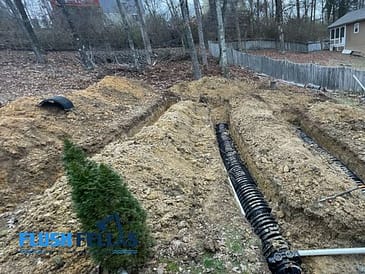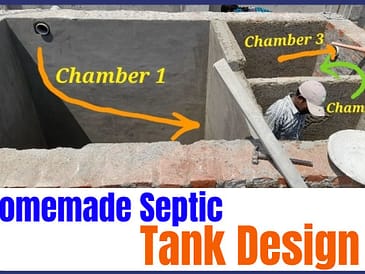No matter if it’s time for cleaning, pumping or replacement of your septic system, it is crucial that you know exactly how much each component costs. Labor is usually between 50-70% of total project expenses.
Most septic tanks are constructed from fiberglass or plastic materials. Concrete models may also be available; however, their installation could prove more expensive and require additional support from surrounding soil layers.
Cost of the Tank
Septic systems are used to effectively dispose of household sewage and waste by collecting it in tanks until its natural breakdown can take place. Due to their complexity, installation must always be handled by professionals; though do-it-yourself (DIY) projects may be possible but this can be costly due to improper installation resulting in backflow in toilets or drain fields overflowing causing backup. Any mistake with installation could cost thousands in repair expenses so it is essential that a system specifically tailored for your home be installed as soon as possible.
The tank is the core component of any septic system and prices typically depend on its capacity. House size plays the biggest role when determining tank requirements; for instance, 3-bedroom homes need larger tanks than 2-bedroom ones. Tank prices typically range from $2,500 to $20,000. Plastic or fiberglass tanks tend to be less costly as they’re lighter and don’t crack as easily like concrete ones do;
Septic systems feature more than just the tank; they also incorporate a distribution box which connects it with the drain field. A distribution box plays a critical role in making sure effluent flows correctly from tank to field; its cost typically ranges between $50 and $100.
Some septic systems require additional layers of protection, like leach field covers or baffles that help prevent solids from reaching the drain field. While this may incur additional expense, such investments could save major headaches in the future.
Additionally, it’s essential to take into account additional costs, like inspection and pumping expenses. Experts advise hiring a professional inspector every three to five years for inspection and pumping purposes, with average inspection costs ranging between $300 to $600 depending on size of tank or scope of inspection.
Cost of the Installation
Septic systems are waste management systems designed to separate and treat wastewater before discharging it in the soil, typically used in rural areas without public sewer access. Proper maintenance is key to keeping costs under control; routine inspections, pumping schedules, limiting what goes down drains, as well as regular pipe cleaning are key. Regular pipe cleaning with either rotary pressure washers or commercial products such as Septic-Scrub can all help keep costs at a manageable level.
Proper functioning of a septic system is critical to protecting both human and environmental health. Wastewater enters groundwater, and if left untreated can contaminate drinking water supplies. To minimize risks associated with improper wastewater disposal systems, the septic tank should be emptied regularly to eliminate sludge and floating scum accumulations from within it.
Costing of installing a new septic system varies based on its type and size of house. A typical installation for homes with three or four bedrooms typically features a 1,000 gallon tank; an installation for such houses typically costs around $1,500.
Soil conditions also play a big part in determining the price of a septic system, with professional conduct a perc test on your property to assess if one can be installed or not. This test measures drainage capability, depth to water table/bedrock depth, terrain depth etc which helps contractors design systems to comply with local regulations.
Installing a septic tank properly on property to avoid contamination requires professional expertise. A skilled installer should make sure the septic tank is placed where it will not become inundated by rainwater or groundwater flooding; depending on its placement this may involve excavation and underground plumbing work; before beginning work on your septic system always obtain a permit first!
No one but an experienced plumber should attempt to install their own septic system; it is a highly complicated job that requires both knowledge and experience for successful installation. Otherwise, you could end up with a faulty system which could result in costly complications.
 Cost of the Drainfield
Cost of the Drainfield
Septic systems are an integral component of home life, helping homeowners to safely dispose of waste in an eco-friendly manner. Like any plumbing system, however, septic tanks may experience issues from time to time that need professional repairs – leakage and clogs in drain fields being common culprits. Fixing them can save both money and keep your family safe.
Installing a drain field requires excavation by a licensed contractor who must ensure an area suitable for drainage is selected, which requires great skill. Furthermore, testing must also take place to make sure soil can support a septic system – this typically costs around $1600 but is essential in this process.
Drain fields are designed to receive wastewater that has been processed and filtered in a tank, before filtering through an extensive network of pipes into soil or groundwater. Their capacity must be sufficient enough to absorb all of your household wastewater – this factor plays a significant role in determining septic system pricing.
An expensive septic system may seem unnecessary for every homeowner, yet they’re essential if they wish to protect their family from dangerous bacteria and pollutants. To lower costs of having one installed, homeowners can install low-flow toilets, use composting toilets and spread laundry out throughout the week instead of only on Saturday mornings.
One way to reduce septic tank costs is by replacing its distribution box. This component connects the tank to the drain field, and its importance cannot be overstated; typically priced from $50-100 depending on material composition.
Professional services offer the most cost-effective solution when it comes to reducing septic tank costs, since septic tanks require technical knowledge that may lead to mistakes that compromise family safety. DIY work may lead to expensive mistakes that put lives in jeopardy.
Cost of the Pump
Dreaming of living the country life often means dreaming without thinking through all of its details, such as waste disposal. Unfortunately, if you move to rural areas, your new house may feature a septic system to treat wastewater and sludge so as to not pollute groundwater supplies, but they do require regular maintenance compared with municipal sewer systems which tend to be much more costly.
Septic tanks are the centerpiece of a septic system. These can be constructed of concrete, plastic or steel – each material having their own advantages and disadvantages as well as costs; concrete costs more than plastic but will outlive both plastic tanks due to increased durability and resistance against corrosion.
Your system will require a distribution box, which acts as the link between your septic tank and drain field. Its cost usually ranges between $50-100. Furthermore, a cover must also be included to protect effluent from weather elements and keep effluent inside its designated space.
Septic jetting lines will come in handy should your system become clogged up. Using pressurized water, they use pressured to force debris out from its hiding places using high pressure jets of water – the cost for this service usually ranges between $150 to $450.
If you’re building a house from scratch, installing your septic tank before framing begins is best. This prevents contractors from having to work around it which could cost more money and delay construction. Finding an experienced contractor with expertise in installing septic systems is also essential as they will have both experience and equipment available that can complete this job safely and quickly.
Assuming your septic system is functioning optimally, there should be very few issues with it. Should a problem arise however, professional plumbers must be brought in immediately as any clogs and other issues could damage your tank, cause waste to back up into your home, pollute local water sources or cause other forms of environmental pollution. Inspect and pump regularly! To keep everything running smoothly.





